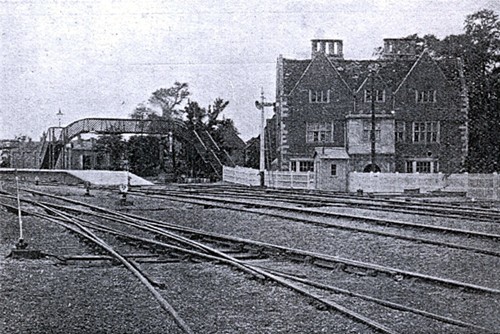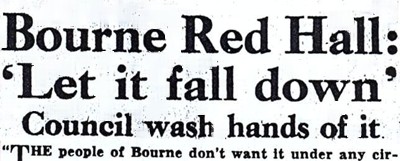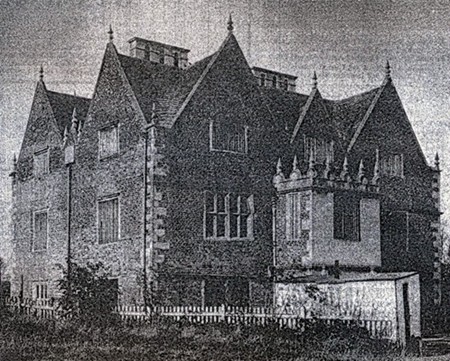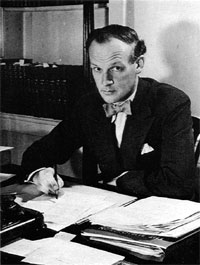|
Disposing of the Red Hall THE NATIONAL TRUST SAYS "NO"
When the Red Hall was threatened
with demolition sixty years ago an attempt was made to pass ownership to
the National Trust and thus save the building for the nation. At that
time, the property was listed as being of special architectural or
historical interest within the provisions of the Town and Country Planning
Act of 1947 and so could not be pulled down without special permission. After the Second World War of 1939-45, the railway system faced drastic changes with nationalisation by a Labour government becoming effective from 1st January 1948 when the major companies were merged to form British Railways as a result of the Transport Act of 1947. This involved upgrading existing rolling stock and premises and as the Red Hall was then regarded as redundant, the LNER offered the building to the National Trust for safekeeping and James Lees-Milne, their historic buildings secretary, drove to Bourne on Tuesday 20th January 1948 to look it over and make a recommendation. But he was not impressed by what he found because he wrote later: It is a nice Jacobean house, seductive from a distance, but unfortunately at the very edge of the railroad and indeed part of the station. It is divided into two tenements, inhabited by a railway labourer and a tailor [Charles W Cator]. Both these people were very kind in showing me over. I was astonished at the deplorable condition of the insides and the friendliness of the inhabitants. The wife of the railwayman inveighed against the LNER for never improving, but the tailor was cheerful and made allowances for his landlords. The wallpapers in both houses was hanging in festoons; damp everywhere; many square panes missing and the holes stuffed with rags. Red Hall is square, of red brick and stone quoins, pointed gables, a central projecting porch with Orders. In one dwelling, the original oak staircase, balustered, and newels bearing obelisks. Upstairs under the roof one large room with gypsum floor called the ballroom; exposed braced timbers overhead. The trust declined to take on responsibility for the Red Hall and for the next twenty years its future remained uncertain while the British Transport Commission, which had then assumed responsibility for it, tried to find a new owner. Other national organisations were asked if they were interested in considering the acquisition of the building as a gift, including the Society for the Protection of Ancient Buildings and the Historic Buildings Council, but all refused. The hall was then offered to the local authorities, Kesteven County Council, South Kesteven Rural District Council and Bourne Urban District Council, but they too declined and even an advertisement in the national press offering it for sale at a nominal sum failed to produce any results. Many councillors, including some from Bourne,
suggested that it should be left to fall down and among them was Councillor H L
Hudson, a member of Bourne Urban District Council and Kesteven County Council
who told a meeting on Thursday 29th July 1954, that it was "a useless building".
The meeting was mainly hostile to any suggestions
that the council should save the building and Alderman G A Jenkinson (Old
Somerby) told members: “The people of Bourne don’t want it under any
circumstances and I will back them absolutely. If Bourne doesn’t want it, why do
we want it? I say let it fall down and the sooner the better.” Councillor Hudson
was one of two councillors from Bourne who were similarly scathing. The commission continued to negotiate for a new owner but by 1961 the building had fallen into considerable disrepair and a report to the public health committee of Bourne Urban District Council in November revealed that a routine check of the water supply still being used by the one remaining tenant, Mr Cator, was polluted. Three samples taken within the space of a few weeks showed faecal coli in the water which was supplied by an overhead storage tank replenished from a private bore on the railway station but no longer in regular use. Mr Cator was advised to boil the water before domestic use and the British Rail estates surveyor was asked to take remedial action to remove the contamination. But the report added: "His reaction indicates that now would be an appropriate moment to secure closure of the building for human habitation pending its removal or demolition. The [Public Health] Act provides that a closing order may be applied in these cases and British Rail would offer no objection." But by then, Bourne United Charities was showing an interest and early in 1962 acquired the freehold of the building and had begun seeking the necessary finance for restoration and future use as a community centre or museum. In October, the clerk to the trustees, Horace Stanton, wrote to Bourne Urban District Council outlining their plans and asking for grant aid. His letter said: The Red Hall is one of the finest examples of Elizabethan architecture in the country and my trustees accepted responsibility for its maintenance in order to prevent its demolition. It was felt that maintenance of the premises should be the responsibility of the county as a whole and not fall entirely on the shoulders of a parochial charity. The trustees were therefore appealing to the Kesteven District, South Kesteven Rural and Bourne Urban District councils for grants towards the cost of necessary repairs. Knowing your council, I feel sure that such an appeal will not fall on deaf ears. You will naturally ask what are the trustees doing themselves and the answer is that they are immediately expending the sum of £3,500 in the premises but unfortunately such a sum will not cover the cost of all necessary repairs. But once repaired, it is estimated that the life of the building will be 500 years. The £3,500 is the first stage of the expenditure necessary and although it is difficult for the architect to give a precise estimate of the total outlay, he roughly estimates the figure to be in the neighbourhood of £6,000." The council deferred a decision on the grant but agreed a token sum of twenty guineas pending the launch of a public appeal. But the die was cast and the restoration of the Red Hall was on the way.
So began a long and determined campaign to find sufficient money to restore the Red Hall and bring it back into useful life for the benefit of the town, a fight led by Councillor Jack Burchnell who became chairman of the trustees of Bourne United Charities. He was also chairman of the appeal committee which soon faced a dramatic increase in the original estimates for restoration over the next decade, but managed to find £35,000 towards the cost [£540,000 at 2008 values], the money coming from the Pilgrim Trust at Boston (£2,000), the Department of the Environment (£5,000), Kesteven County Council (£800), Bourne Urban District Council (£1,300), South Kesteven Rural District Council (£1,000) and the balance from the people of Bourne through various donations and fund raising schemes. Councillor Burchnell had access to earlier plans of the house which guided his restoration scheme and by November 1970 the tall Elizabethan chimneys which has been dismantled in 1957 because they had become dangerous and unsafe had been rebuilt in exact detail and using the original red bricks that had fortunately been preserved. Fireplaces, walls and other interior structures which had been drastically altered during the 19th century to suit various changes of use were removed and the huge windows replaced by the more interesting and complicated Elizabethan style mullioned lights while the wattle and daub construction surviving in many walls was replaced by modern plaster. The roof, however, survived more or less intact because the same Collyweston slate was still available for restoration. Work was well advanced with £10,000 already spent when the Lincolnshire Free Press reported on 10th November 1970: "When the Red Hall is completed, the trustees hope that they will be able to place the house at the disposal of the general public as perhaps an art or recreational centre open to anyone wishing to take advantage of the facilities it will provide. Money is slow in coming in but before long, Bourne will have one of the finest Elizabethan houses in the country." The scheme was finally completed two years later and the hall reopened on Saturday 2nd December 1972 as a community centre, as was envisaged. It remains in use to this day, mainly as offices of BUC, but the public events which marked its new lease of life are a thing of the past and although some local organisations do meet there, the trustees do not now open the building to the public even on the Open Days organised annually by English Heritage and few people today have ever been inside. NOTE: The tailor referred to by James Lees-Milne in his 1948 report, Charles W Cator, used a portion on the north side of the building as a workshop and living accommodation for himself and his wife. He lived there for thirty years and was still in residence until ownership passed to Bourne United Charities although the British Transport Commission eventually found him alternative accommodation after the adverse report on the water supply.
WRITTEN JULY 2009 Return to The Red Hall
Go to: Main Index Villages Index |
||||||||



